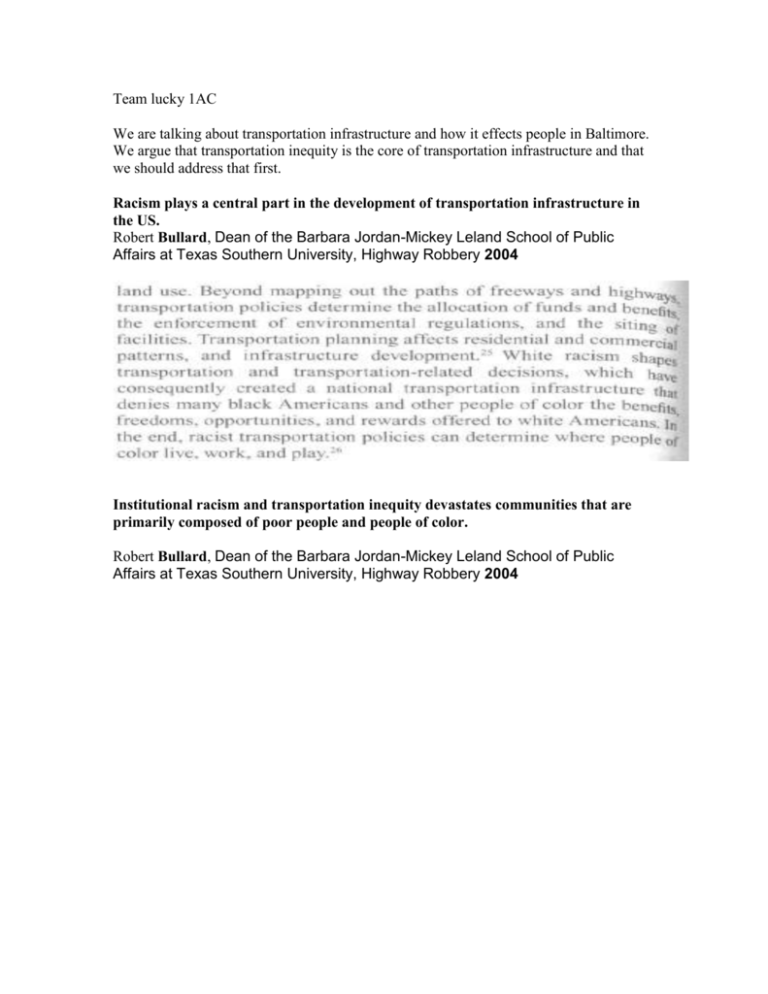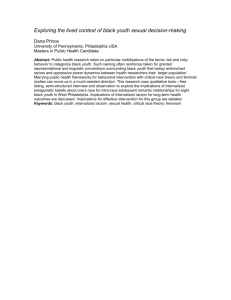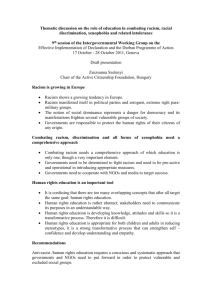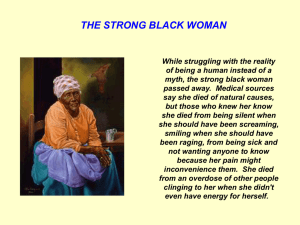Team lucky 1AC
advertisement

Team lucky 1AC We are talking about transportation infrastructure and how it effects people in Baltimore. We argue that transportation inequity is the core of transportation infrastructure and that we should address that first. Racism plays a central part in the development of transportation infrastructure in the US. Robert Bullard, Dean of the Barbara Jordan-Mickey Leland School of Public Affairs at Texas Southern University, Highway Robbery 2004 Institutional racism and transportation inequity devastates communities that are primarily composed of poor people and people of color. Robert Bullard, Dean of the Barbara Jordan-Mickey Leland School of Public Affairs at Texas Southern University, Highway Robbery 2004 The current structure of transportation infrastructure can be attributed to the “possessive investment in whiteness.” George Lipsitz, Professor. Department of Black Studies University of California, Santa Barbara. The Possessive Investment in Whiteness. 2005 The federal government has played a major role in augmenting the possessive investment in whiteness. For years, the General Services Administration routinely channeled the government’s own rental and leasing business to realtors who engaged in racial discrimination, while federally subsidized urban renewal plans reduced the already limited supply of housing for communities of color through “slum clearance” programs. In concert with FHA support for segregation in the suburbs, federal and state tax monies routinely funded the constructuion of water supplies and sewage facillitites for racially exclusive suburban communities in the 1940’s and 1950’s. By the 1960’s, these areas often incorporated themselves as independent municipalities in order to gain greater access to federal funds allocated for “urban aid.” At the same time that FHA loans and federal highway building projects subsidized the growth of segregated suburbs, urban renewal programs in cities throughout the country devastated minority neighborhoods. During the 1950’s and 1960’s, federally assisted urban renewal projects destroyed 20 percent of the central city housing units occupied by blacks, as opposed to only 10 percent of those inhabited by whites. More than 60 percent of those displaced by urban renewal were African Americans, Puerto Ricans, Mexican Americans, or members of other minority racial groups. The Federal Housing Administration and the Veterans Administration financed more than $120 billion worth of new housing between 1934 and 1962, but less than 2 percent of this real estate was available to non-white families-and most of that small amount was allocated in segregated areas. The possessive investment in whiteness in the form of transportation infrastructure investment has devastated communities of color and has benefitted white surburbanites. George Lipsitz, Professor. Department of Black Studies University of California, Santa Barbara. The Possessive Investment in Whiteness. 2005 Federally funded highways designed to connect suburban commuters with downtown places of employment also destroyed already scarce housing in minority communities and often disrupted neighborhood life as well. Construction of the Harbor Freeway in Los Angeles, the Gulf Freeway in Houston, and the Mark Twain Freeway in St. Louis displaced thousands of residents and bisected neighborhoods, shopping districts, and political precincts. The process of urban renewal and highway construction set in motion a vicious cycle: population loss led to decreased political power, which made minority neighborhoods more vulnerable to further urban renewal and freeway construction, not to mention more susceptible to the placement of prisons, incinerators, toxic waste dumps, and other projects that further depopulated these areas. Katrina is a glairing example of the nearly unimaginable devastation that results from insufficient transportation infrastructure. Masozera, Bailey, and Kerchner—2006 (Michel Masozera, Gund Institute for Ecological Economics, The University of Vermont, Rubenstein School of Enviornment and Natural Resources, Melissa Bailey, Master of Public Administration Program, The University of Vermont, Charles Kerchner, Department of Community Development and Applied Economics, The University of Vermont, “Distribution of impacts of natural disasters across income groups: A case study of New Orleans,” 6/9/06, http://www.sciencedirect.com/science?_ob=ArticleURL&_udi=B6VDY-4KPFKNM1&_user=16764&_rdoc=1&_fmt=&_orig=search&_sort=d&_docanchor=&view=c&_sea rchStrId=937966850&_rerunOrigin=google&_acct=C000001898&_version=1&_urlVers ion=0&_userid=16764&md5=ff609daa40a7264aa6e9b15304ab3849) 4.1. Ability to respond: transportation While our analyses show that low-income residents were not more likely to be harder hit by the physical event of Hurricane Katrina, there is evidence to suggest that they were disadvantaged during the response phase due to lack of transportation. Transportation is a major component in any emergency preparedness and evacuation plan. Unequal access to transportation alternatives in natural disasters increases the vulnerability of the poor, elderly, and disabled people. One of the factors that increased the vulnerability of lower income groups in New Orleans was the lack of access to transportation to evacuate the city as Hurricane Katrina approached. As of 2004, 1 in 5 New Orleans households did not have access to a car, truck, or van for private use. However, twentyeight percent of households had two vehicles and another 6% had three or more (US Census Bureau, American Community Survey, 2004). As illustrated in Fig. 3, we found a positive correlation between the percentage of residents living below the poverty level and the percentage of residents who did not own a vehicle for neighborhoods in New Orleans. Thus, there was a wide variance in households' ability to appropriately respond to the hurricane, with those in poverty lacking the resources needed to evacuate. Lack of adequate transportation explains, in part, why more than 20,000–30,000 residents were stranded in the Superdome (Center for Progressive Reform, 2005). Our findings, which suggest that low-income neighborhoods were more vulnerable during the response phase, are consistent with previous research. A study done by Gladwin and Peacock (1997) reported people with lower incomes are less able and less likely to evacuate in the case of a natural disaster, due to a lack of transportation. Morrow and Enarson (1996) found that poor women are generally unable to evacuate when a disaster hits because they lack economic resources for supplies and transportation. We affirm the resolution as act of reconceptualizing transportation infrastructure. Transportation equity requires an expansive re-evaluation of transportation infrastructure policy. Thomas Sanchez & Marc Brenman, Director and Associate Professor Urban Affairs and Planning Program Virginia Tech & Executive Director Washington State Human Rights Commission. TRANSPORTATION EQUITY AND ENVIRONMENTAL JUSTICE: LESSONS FROM HURRICANE KATRINA. 2007 Efforts to challenge discrimination, segregation, and inequitable transportation policies have become increasingly sophisticated to encompass a broad range of related social impacts. The term transportation equity refers to a range of strategies and policies that aim to address inequities in the nation’s transportation planning and project delivery system. Across the country, community-based organizations of low-income and minority residents are organizing to improve their communities, and they are recognizing the significant role played by transportation in shaping local opportunities and disinvestment. Though the definition of transportation equity may vary from place to place, most of these community residents would agree that an equitable transportation system would: • Ensure opportunities for meaningful public involvement in the transportation planning process, particularly for those communities that most directly feel the impact of projects or funding choices • Be held to a high standard of public accountability and financial transparency • Distribute the benefits and burdens from transportation projects equally across all income levels and communities • Provide high quality services—emphasizing access to economic opportunity and basic mobility—to all communities, but with an emphasis on transit-dependent populations • Equally prioritize efforts both to revitalize poor and minority communities and to expand transportation infrastructure Racism can be expressed with a violent Fist or a Velvet glove. Contemporary Racism has slipped on the velvet glove, invoking a devastating power of illusion by focusing merely on individual bigotry leaving untouched society’s racist systems and institutions. BARDNT Director of Crossroads, a non profit Organization 1991 Joseph-ordained minister; “Dismantling Racism: The Continuing Challenge to White America; p.31-33 Racism can be expressed with an iron fist or with a velvet glove. At its coarsest and most unsophisticated, racism uses violence to enforce explicit laws to subjugate and control. Examples of such racism are the practice of slavery in the United States, the genocide of Jews in Nazi Germany, and the system of apartheid in South Africa. The evil of such blatant racism is obvious. Racism also assumes sophisticated forms that depend less on brute force than on psychological methods that dissipate resistance. In such forms, racism may in fact create the illusion that it does not exist and therefore be far more difficult to detect and eliminate. Yet its power to oppress is no less than that of open and blatant racism. Iron fist or velvet glove, the results are the same. For example, under a blatant form of racism, laws explicitly dictate where members of the subjugated race can live, the limits of their education, and the kind of work they must do. As a result, they are undereducated, underemployed, and ghettoized. However, under a more sophisticated system of racism, members of the same race have no explicit restrictions on where they live, no legal limitations on their education, nor on the kind of jobs they can have. Yet, they are still undereducated, underemployed, and ghettoized. It is, of course, emphatically denied that racism exists, but it obviously does exist because of the observable results. It is this sophisticated form that racism has taken in the United States, particularly during the past thirty years, and that we are seeking to describe e and define in this book. If racism is prejudice plus power, then contemporary racism’s greatest power is this ability to create illusions and delude victims and perpetrators alike. It deludes the victims into believing that their rulers have only their best interests at heart. It deludes the dominant group into believing that it is not racist, that it is treating its victims well, and that This power to create illusions is devastating, for it provides justification to the dominant group for its actions. A few more examples may be helpful here. We have already seen the illusion that is created when racism is described simply in terms of personal prejudice and individual bigotry. As we discussed a few pages earlier, such an understanding of racism does not begin to explain racism’s incredible power. Yet, as long as this illusion is maintained, the energy for change will be focused only on improving individual attitudes and actions, and the actual power of racism which is lodged in society’s systems and institutions will be untouched. there is no need to change. Another illustration is the illusion that the victims of racism are responsible for their own plight. Racism’s victims are blamed for their problems in many ways. In our nation’s inner cities, people of color are blamed for the deteriorating condition of their housing, even though it began long before they came there and continued because of their forced overcrowding. They are blamed for their unemployment and underemployment, even though our economic system requires varying degrees of unemployment in order to maintain itself. Amazingly, this illusion is so successful that even the victims of racism often believe that their suffering is It is, therefore, a matter of great importance to them, as well as to us, to find ways of exposing the disguises and illusions that hide racism’s power. We will be able to a product of their own failures. comprehend the definition of racism as prejudice plus power only to the degree that we are able to see this power at work. One of the reasons we are fooled by such illusions is that most of us do not participate directly in the enforcing of our prejudices. We do not actually feel as though we are exercising the power that results in victimizing people of color. We do participate, however, even when this power is exercised for us by others in ways that are to our benefit.








